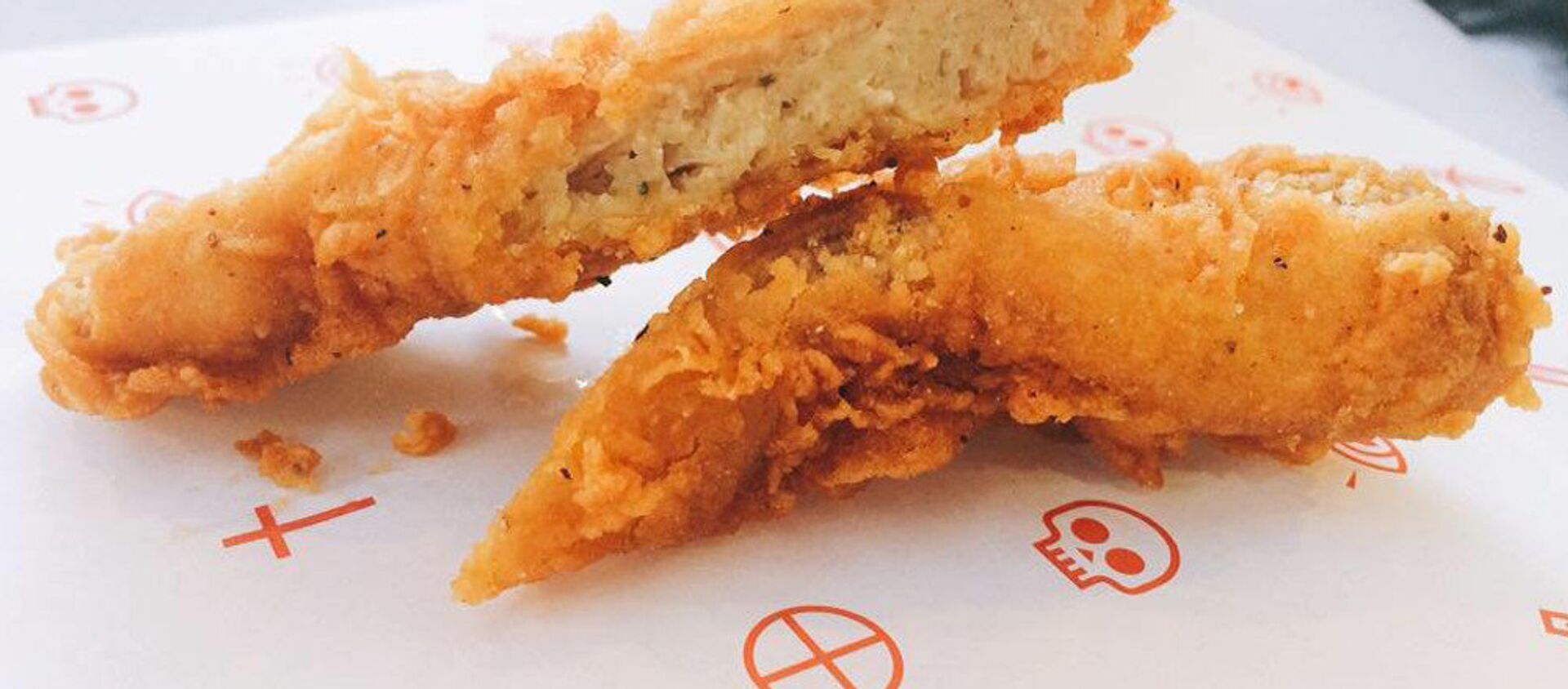https://sputnikglobe.com/20220525/lab-grown-meat-coming-soon-to-a-store-near-you-worlds-largest-bioreactors-begin-construction-in-us-1095779070.html
Lab-Grown Meat Coming Soon to a Store Near You: World’s Largest Bioreactors Begin Construction in US
Lab-Grown Meat Coming Soon to a Store Near You: World’s Largest Bioreactors Begin Construction in US
Sputnik International
Plant-based meat alternatives are growing exponentially in the US, reaching $1.4 billion in sales in the United States in 2020. But lab-grown meat that is... 25.05.2022, Sputnik International
2022-05-25T19:42+0000
2022-05-25T19:42+0000
2022-08-06T13:32+0000
chicken
lab-grown beef
meat
technology
conservation
science & tech
https://cdn1.img.sputnikglobe.com/img/07e6/05/19/1095778948_0:162:893:664_1920x0_80_0_0_f8579a024ae93ea4a80c57b37adcca41.png
Good Meat announced that they have begun construction on the world’s largest bioreactors to create lab-grown meat that is nearly indistinguishable from farm-raised meat. They estimate that the new lab will be capable of supplying meat to tens of thousands of stores and restaurants around the country and the world.The San Francisco-based startup is just one of around 170 companies working on cultivated meat, also called lab-grown meat, in vitro meat, or cellular agriculture.The company was the first to sell lab-grown meat commercially, and has been providing chicken for chicken nuggets to a restaurant in Singapore since 2020. The new US facility will be capable of creating 13,700 tonnes of chicken or beef annually.Conventional meat agriculture has a huge impact on the environment. A study estimated that eliminating meat and dairy from our diets would reduce the farmland needed to feed the world by 75%, an area equivalent to the size of the United States, China, the European Union and Australia combined. The same study found that the loss of habitat due to agricultural development is the single greatest contributor to the mass extinction event scientists say we are in the midst of.But people simply love meat too much to stop eating it. Global demand has more than tripled over the past 50 years, and the world currently produces more than 340 million tonnes of meat every year.Cultivated meat will use less land, produce fewer greenhouse emissions and isn’t pumped full of hormones, antibiotics or present the risk of contaminants like E.Coli and salmonella.Plant-based alternatives, like those made from Beyond Meat and Impossible Burger, are increasing in popularity and have made great progress in simulating the taste and texture of real meat, but they still fall short of truly being meat.Cultivated meat, on the other hand, is chemically identical to meat that comes from a slaughtered animal. It starts by taking a cell from a living animal and putting it in a growing serum until it becomes a viable culture called a cell line. Previously, that growing serum was created using bovine fetuses, but Good Meat says it created one that does not require byproducts from slaughtered animals, making it truly a “death free” meat.Once a cell line is created, scientists take a small sample from it and feed it until the cells reproduce enough to form patties that can then be sold to stores and restaurants.Construction has already begun on the 10 new bioreactors, though a final site for them has yet to be picked. That should come in the next three months. Once constructed, the bioreactors will stand about 56 feet high and have a capacity of 250,000 liters or about 66,043 gallons. Combined, they will exceed the capacity of an olympic-sized swimming pool. The facility will be operational in 2024 and will reach its top capacity of 13,700 tonnes of meat a year by 2030.The company is also creating a 6,000 liter bioreactor at its Singapore location that is expected to be completed early in 2023. That bioreactor will be the world’s largest until the US facility is completed the following year.There is some worry that scaling up so quickly will present unforeseen challenges, but Good Meat believes they are prepared to deal with them. Combined with its parent company Eat Just, which also makes plant-based alternatives, the two companies have raised $728 million in capital since Eat Just’s founding in 2014, according to Crunchbase.There is also another challenge facing Good Meat and companies like it. While creating a minced or ground meat is relatively trivial, creating different cuts of meat, like a T-bone steak or filet mignon is far more difficult. That is because there is a lot more to meat than just meat.The meat that comes from slaughtered animals come with tendons, fat, and muscles. The age of the animal, how much it exercises, and most importantly what part of the animal it comes from all have a major impact on its texture, feel, and flavor. And while the lack of bones is generally seen as an advantage of cultivated meat, any experienced barbeque chef will tell you that they can impact a lot of flavor on their own.There are technologies being developed that hope to solve that issue using 3d printers and cell lines created with different kinds of cells from animals, but that may be a while off yet. Another California based startup, Wildtype, has managed to create a cultivated salmon filet that reportedly has a similar texture to real salmon filets, but that is a relatively simple task compared to making realistic feeling filet mignon.For now, Good Meat is focused on the easier task of making minced or ground meat, along with getting their food to customers around the nation. The FDA has yet to approve cultivated meat for consumption in the United States.
https://sputnikglobe.com/20160806/food-production-meat-1044006015.html
https://sputnikglobe.com/20170915/china-signs-300-million-israel-lab-meat-1057440550.html
https://sputnikglobe.com/20190219/vegan-meat-india-1072560994.html
Sputnik International
feedback@sputniknews.com
+74956456601
MIA „Rossiya Segodnya“
2022
News
en_EN
Sputnik International
feedback@sputniknews.com
+74956456601
MIA „Rossiya Segodnya“
Sputnik International
feedback@sputniknews.com
+74956456601
MIA „Rossiya Segodnya“
chicken, lab-grown beef, meat, technology, conservation, science & tech
chicken, lab-grown beef, meat, technology, conservation, science & tech
Lab-Grown Meat Coming Soon to a Store Near You: World’s Largest Bioreactors Begin Construction in US
19:42 GMT 25.05.2022 (Updated: 13:32 GMT 06.08.2022) Plant-based meat alternatives are growing exponentially in the US, reaching $1.4 billion in sales in the United States in 2020. But lab-grown meat that is chemically identical to real meat is set to become another alternative in the coming years.
Good Meat
announced that they have begun construction on the world’s largest bioreactors to create lab-grown meat that is nearly indistinguishable from farm-raised meat. They estimate that the new lab will be capable of supplying meat to tens of thousands of stores and restaurants around the country and the world.
The San Francisco-based startup is just one of around 170 companies working on cultivated meat, also called lab-grown meat, in vitro meat, or cellular agriculture.
The company was the first to sell lab-grown meat commercially, and has been providing chicken for chicken nuggets to a restaurant in Singapore since 2020. The new US facility will be capable of creating 13,700 tonnes of chicken or beef annually.
Conventional meat agriculture has a
huge impact on the environment. A study estimated that eliminating meat and dairy from our diets would reduce the farmland needed to feed the world by 75%, an area equivalent to the size of the United States, China, the European Union and Australia combined. The same study found that the loss of habitat due to agricultural development is the single greatest contributor to the mass extinction event scientists say we are in the midst of.
But people simply love meat too much to stop eating it. Global demand has more than tripled over the past 50 years, and the world currently produces more than 340 million tonnes of meat every year.
Cultivated meat will use less land, produce fewer greenhouse emissions and isn’t pumped full of hormones, antibiotics or present the risk of contaminants like E.Coli and salmonella.
Plant-based alternatives, like those made from Beyond Meat and Impossible Burger, are increasing in popularity and have made great progress in simulating the taste and texture of real meat, but they still fall short of truly being meat.
Cultivated meat, on the other hand, is chemically identical to meat that comes from a slaughtered animal. It starts by taking a cell from a living animal and putting it in a growing serum until it becomes a viable culture called a cell line. Previously, that growing serum was created using bovine fetuses, but Good Meat says it created one that does not require byproducts from slaughtered animals, making it truly a “death free” meat.

15 September 2017, 21:48 GMT
Once a cell line is created, scientists take a small sample from it and feed it until the cells reproduce enough to form patties that can then be sold to stores and restaurants.
Construction has already begun on the 10 new bioreactors, though a final site for them has yet to be picked. That should come in the next three months. Once constructed, the bioreactors will stand about 56 feet high and have a capacity of 250,000 liters or about 66,043 gallons. Combined, they will exceed the capacity of an olympic-sized swimming pool. The facility will be operational in 2024 and will reach its top capacity of 13,700 tonnes of meat a year by 2030.
The company is also creating a 6,000 liter bioreactor at its Singapore location that is expected to be completed early in 2023. That bioreactor will be the world’s largest until the US facility is completed the following year.
There is some worry that scaling up so quickly will present unforeseen challenges, but Good Meat believes they are prepared to deal with them. Combined with its parent company Eat Just, which also makes plant-based alternatives, the two companies have raised $728 million in capital since Eat Just’s founding in 2014,
according to Crunchbase.
There is also another challenge facing Good Meat and companies like it. While creating a minced or ground meat is relatively trivial, creating different cuts of meat, like a T-bone steak or filet mignon is far more difficult. That is because there is a lot more to meat than just meat.

19 February 2019, 13:24 GMT
The meat that comes from slaughtered animals come with tendons, fat, and muscles. The age of the animal, how much it exercises, and most importantly what part of the animal it comes from all have a major impact on its texture, feel, and flavor. And while the lack of bones is generally seen as an advantage of cultivated meat, any experienced barbeque chef will tell you that they can impact a lot of flavor on their own.
There are technologies being developed that hope to solve that issue using 3d printers and cell lines created with different kinds of cells from animals, but that may be a while off yet. Another California based startup, Wildtype, has managed to create a cultivated salmon filet that reportedly has a similar texture to real salmon filets, but that is a relatively simple task compared to making realistic feeling filet mignon. For now, Good Meat is focused on the easier task of making minced or ground meat, along with getting their food to customers around the nation. The FDA has yet to approve cultivated meat for consumption in the United States.
“We’ve submitted our application. We’ve found the agency to be fully engaged, asking all the questions you’d expect, from cell identification to final product,” Josh Tetrick, the chief executive of Eat Just, told The Guardian. “We’d prefer not to try to predict if and when [approval] will occur.”




